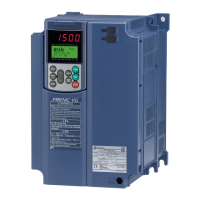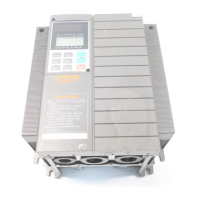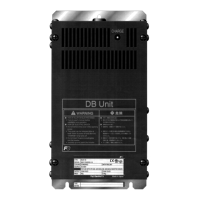5.3 Description of Function Codes
5-164
■ Speed limit value by analog input (E61, E62 and E63)
You can also enter from the analog input the speed limit value. Refer to E61, E62 and E63.
• Forward speed limit level = Maximum frequency 1 (F03) × FWD speed limit value (analog input) (%)
• Reverse speed limit level = Maximum frequency 1 (F03) × REV speed limit value (analog input) (%)
■ Over speed detection level (120% of the specified speed limit levels)
If a regenerative load (which is not generated usually) is generated under droop control or function codes are
incorrectly configured, then the motor may rotate at an unintended high speed. To protect the machinery, it is
possible to specify the overspeed level with d32 and d33 as follows.
• Forward overspeed level = Maximum frequency 1 (F03) × Speed limit 1 (d32) × 120 (%)
• Reverse overspeed level = Maximum frequency 1 (F03) × Speed limit 2 (d33) × 120 (%)
■ Over speed detection level (d35)
Setting d35 data to “999(factory default)” causes the inverter to issue an over speed alarm if either of the above
conditions are satisfied.
or
Motor speed = 200 Hz (120Hz at [ND] mode) × (d32 or d33) × 120(%)
d35 specifies the over speed detection level by percentage of the maximum frequency (F03/A01).
• Over speed level = Maximum frequency 1 (F03/A01) × d35
Running/stopping the motor
Under torque control, the inverter does not control the speed, so it does not perform acceleration or
deceleration by soft
cceleration/deceleration time) at the time of startup and stop.
Turning ON a run command starts the inverter to run and output the commanded torque. Turning it OFF
stops the inverter so that the motor coasts to a stop.
Thermistor (for motor) (Mode selection and level)
These function codes specify the PTC (Positive Temperature Coefficient) thermistor embedded in the motor. The
thermistor is used to protect the motor from overheating or output an alarm signal.
■ Thermistor (for motor) (mode selection) (H26)
H26 selects the function operation mode (protection or alarm) for the PTC thermistor as shown below.
H26 data Action
0 Disable
1 When the voltage sensed by PTC thermistor exceeds the detection level, motor
protective function (alarm 0h4 ) is triggered, causing the inverter to enter an alarm stop
state.
2 When the voltage sensed by the PTC thermistor exceeds the detection level, a motor
alarm signal is output but the inverter continues running.
You need to assign the “Motor overheat detected by thermistor” signal (“THM”) to one
of the digital output terminals beforehand, by which a temperature alarm condition is
indicated to the peripheral equipment (E20, E21 and E27, data = 56).
If H26 data is set to “1” or “2” (PTC thermistor), the inverter monitors the voltage sensed by PTC thermistor and
protects the motor even when the 2nd motor is selected.

